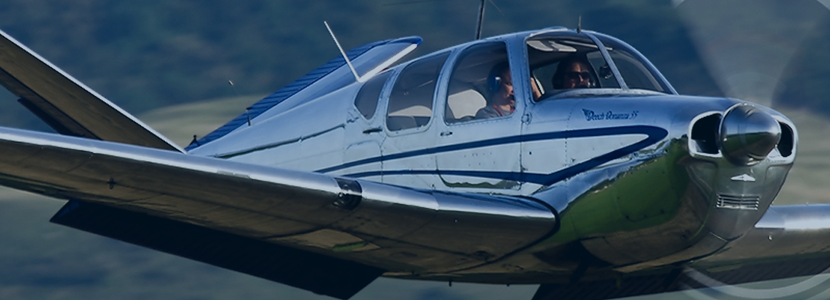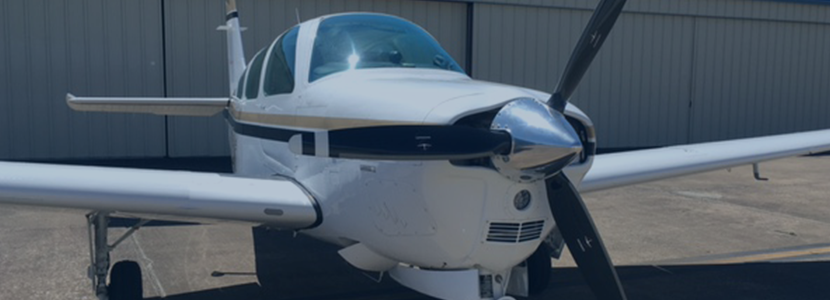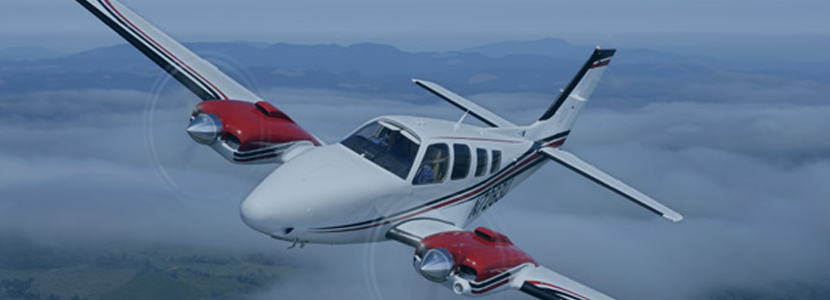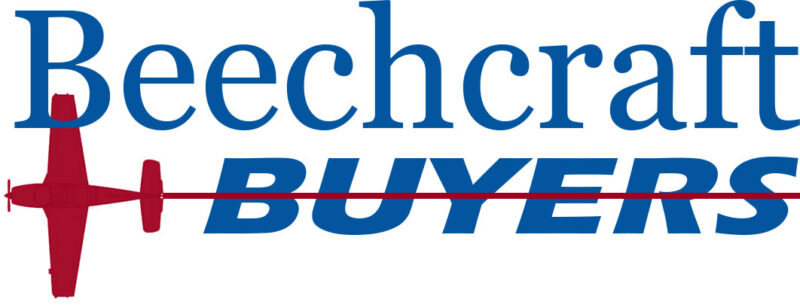To better assist you in your purchase decision(s), we have provided a list and specifications of Beechcraft aircraft in which we specialize and have most familiarity with. We do work with other models and can do so upon request.
Popular Beechcraft Aircraft we work with
V35 Bonanza


Speeds
-
- Top speed at sea level 210 MPH
- Maximum recommended cruise power (214 HP)
- The cruise speed at 75% power at 6500 feet (optimum altitude) full throttle, 2500 RPM 203 MPH
- Stall speed (landing, full flaps) 63 MPH
- Airspeed limits Maneuvering 152 MPH
- Maximum structural cruising 190 MPH
- Never exceed 225 MPH
- Flaps extended (normal) 140 MPH
- Landing gear extended (normal) 175 MPH
- Fuel / Range
- Standard fuel capacity 50 gallons
- Maximum range (at 163 MPH at 10,000 feet) with standard tanks 600 miles, with extended range tanks (80 gallons total) 1110 miles (Ranges include allowance for warm-up, taxi, takeoff, climb, and a 45-minute reserve at 45% power.)
- Fuel 100/130 octane minimum
Weight
-
- Gross weight 3400 pounds
- Empty weight (includes standard avionics) 1985 pounds
- Useful load 1415 pounds
The model designation didn’t change from the previous model, but nevertheless, the 1972 edition of the V35B is considered a model change. The interior underwent a major redesign which was so extensive that many structural changes had to be made in the cabin particularly the roof to accommodate the all new interior. The 1972 V35B Bonanza features a more durable interior with an improved overhead ventilation system and more head room. Cabin chairs and the instrument panel were also restyled. It can also be distinguished from earlier V35Bs by its new paint design. Empty weight is up slightly over that of the 1971 V35B, otherwise performance is unchanged.
Serials of 1972 V35B production start with D-9287. The price was initially $41,600.
1.Ball, Larry A., Those Incomparable Bonanzas, McCormack and Armstrong, Co.,Inc. 1971
F33 Bonanza


Speeds
-
- Top speed at sea level 195 MPH
- Maximum recommended cruise power 75% (169 HP)
- Cruise speed at 75% power at 7000 feet (optimum altitude) full throttle, 2450 RPM 185 MPH
- Stall speed (landing, full flaps) 60 MPH
- Rate of climb at sea level 930 feet per minute
- Airspeed limits Maneuvering 147 MPH
- Maximum structural cruising 185 MPH
- Never exceed 225 MPH
- Flaps extended (normal)140 MPH
- Landing gear extended (normal) 175 MPH
- Fuel / Range
- Standard fuel capacity 50 gallons
- Maximum recommended cruise power 75% (169 HP)
- Cruise speed at 75% power at 7000 feet (optimum altitude) full throttle, 2450 RPM 185 MPH
- Maximum range (at 142 MPH at 10,000 feet) with standard tanks 880 miles, with extended range tanks (80 gallons total) 1430 miles (Ranges include an allowance for warm-up, taxi, takeoff, climb, and a 45-minute reserve at 45% power.)
- Service ceiling 17,800 feet
Weight
-
- Gross weight 3050 pounds
- Empty weight (includes standard avionics) 1885 pounds
- Useful load 1165 pounds
Further refinement of the original Model 33. Still using the 225 horsepower Continental IO-470-K, the F33 was the 1970 version and began with serial CD-1235. Like the other 1970 Bonanzas, it featured a 3-light landing gear down indication system, a redesigned switch panel, new improved engine and fuel quantity instruments (Baron type), and a quick opening cowling. Optional internally lighted instruments were available and electroluminescent instrument panel placard lighting was standard for brighter, more uniform night lighting. Performance remained unchanged from the E33. Empty weight increased.
OTHER NEW F33 FEATURES AND CHANGES:
-
- Anti-slosh fuel cells (to prevent inadvertent unporting of fuel line during slips, skids, and turning takeoffs with low fuel in tank.)
- Third side window shape changed to that used on the V35B.
- New, lower glareshield with diffused lighting.
- New high back seats with molded shell backs.
- Quieter and more attractive, pilot’s storm window.
- New entry and exit assist handle.
- Improved armrests (optional).
- Optional door courtesy light.
- Optional recessed control wheel map light.
- Optional Brittian B-VII autopilot.
- Thicker pilot’s side window.
- Improved parking brake handle.
- New interior and exterior styling.
THESE CHANGES OCCURRED DURING PRODUCTION:
-
- Smaller diameter control lock pin, CD-1240 and after.
- Higher capacity 232 CW pressure pump, CD-1244 and after.
- Single center armrests (optional) to increase hip room (also seat contour change), CD-1245 and after.
- Landing gear position indication improvement (relay added to the landing gear motor to prevent any early “green†indications from the wheel well switches in advance of the motor completing its cycle), CD-1253 and after.
- Improved storm window seal, CD-1254 and after.
- The F33s are serials CD-1235 through CD-1254. Only 20 units. All were manufactured during 1970 and the price was $34,150.
.1.Ball, Larry A., Those Incomparable Bonanzas, McCormack and Armstrong, Co.,Inc. 1971
A36 Bonanza


Speeds
-
- Top speed at sea level 204 MPH
- Maximum recommended cruise power 75% (214 HP)
- Cruise speed at 75% power at 6500 feet (optimum altitude) full throttle, 2500 RPM 195 MPH
- Stall speed (landing, full flaps)…64 MPH
- Maneuvering 160 MPH
- Maximum structural cruising 190 MPH
- Never exceed 234 MPH
- Flaps extended (normal) 140 MPH
- Landing gear extended (normal) 175 MPH
- Fuel / Range
- Standard fuel capacity 50 gallons
- Maximum range (at 167 MPH at 10,000 feet) with standard tanks 530 miles, with extended range tanks (80 gallons total) 980 miles (Ranges include allowance for warm-up, taxi, takeoff, climb, and a 45-minute reserve at 45% power.)
- Service ceiling 16,000 feet
- Fuel 100/130 octane minimum
Weight
-
- Gross weight 3600 pounds
- Empty weight (includes standard avionics) 2023 pounds
- Useful load 1577 pounds
The original Beech factory approach to marketing the Model 36 was to advertise it as an aerial moving van, an air taxi, a carry-all, an ideal charter air plane for the fixed base operator. Although the Model 36 was all of these, this marketing approach didn’t sell many airplanes. Most of the firms in the business of charter and air taxi were captive, that is, they were dealers for one of the major airplane manufacturers. Few Piper and Cessna dealers could be swayed into using a Model 36 in their business, and the Beech outlets would use it anyway without this marketing appeal.
Beginning with 1970 production the Model 36 became the A36 and acquired a new look. All the plushness associated with the tail Bonanzas (an interior which had been optional on the first 36s) became standard to the A36. Advertising emphasis was shifted to the owner market which had bought so many Bonanzas over the years.
Features differentiating the A36 from its predecessor are a three-light landing gear down indication system, a redesigned lower instrument panel, new improved engine and fuel quantity instruments (Baron type), and a quick opening cowling. The A36 also features optional internally lighted instruments and standard electroluminescent instrument panel placard lighting for brighter, more uniform night lighting. Empty weight is up over the Model 36, otherwise performance is unchanged.
1.Ball, Larry A., Those Incomparable Bonanzas, McCormack and Armstrong, Co.,Inc. 1971.
B55 Baron


Speeds
-
- Powered by two Continental 6-cylinder IO-470-L fuel-injected engines making 260 horsepower each. Equipped with avionics.
- Maximum Speed 201 Kts. / 230mphCruising Speeds (TAS at Average Cruise Weight)
- 6,000 ft. (77% MCP) 188Kts. / 200Mph10,000 ft. (66% MCP) 184Kts. / 200Mph12,000 ft. (56% MCP) 173Kts. / 200Mph
Fuel / Range
-
- Cruise Range For 136 Gallons Usable
(Includes allowance for fuel used during Start, Taxi, Takeoff, Climb, and minute reserve at Economy Cruise Power; Weight Before Start.) - 6,000 ft. (77% MCP) 798 N.M.
10,000 ft. (66% MCP) 907N.M.
12,000 ft. (56% MCP) 991 N.M.
- Cruise Range For 136 Gallons Usable
Weight
-
- Rate of Climb (at 5,100 lbs.)
*Two engines Sea Level
*Single engine Sea Level
- Rate of Climb (at 5,100 lbs.)

We work with you as a team.
If you are looking for the best Beechcraft available that meets your needs, call us. Or, if you have additional questions please feel free to communicate with us at your leisure.
